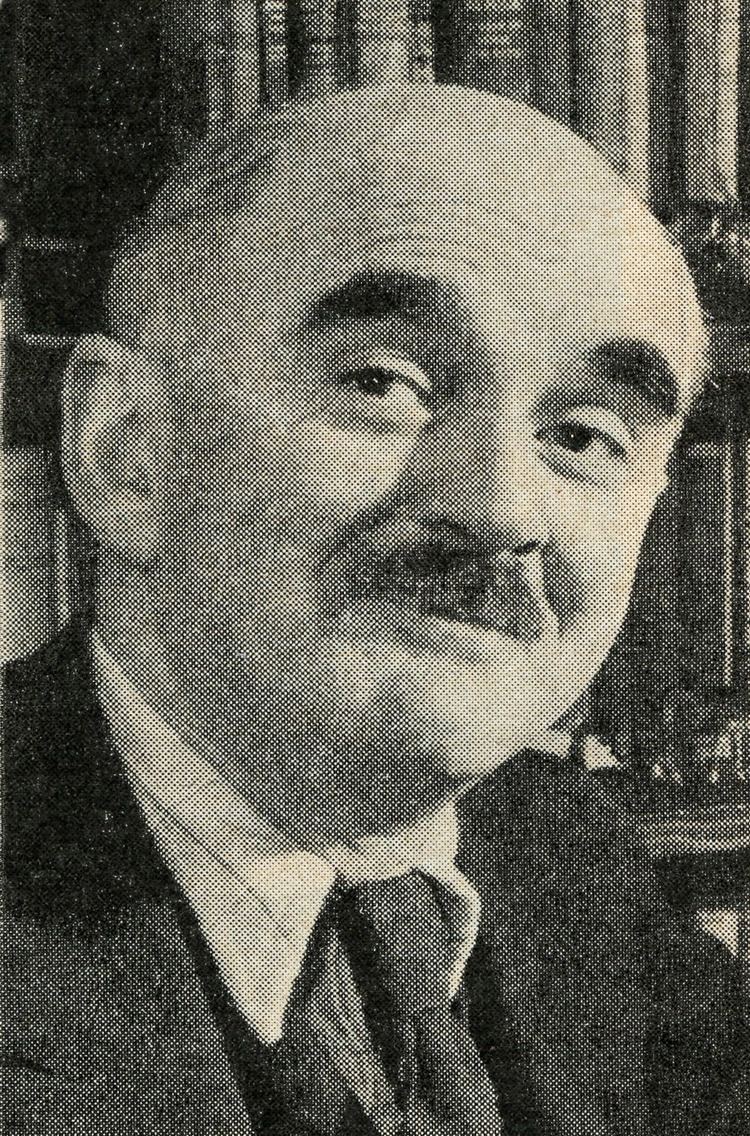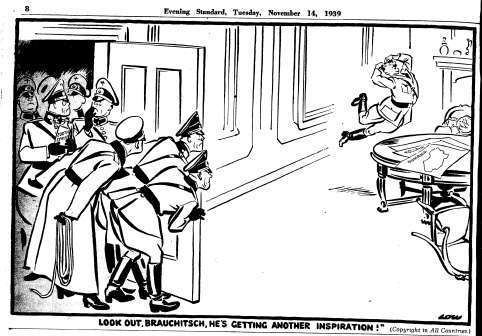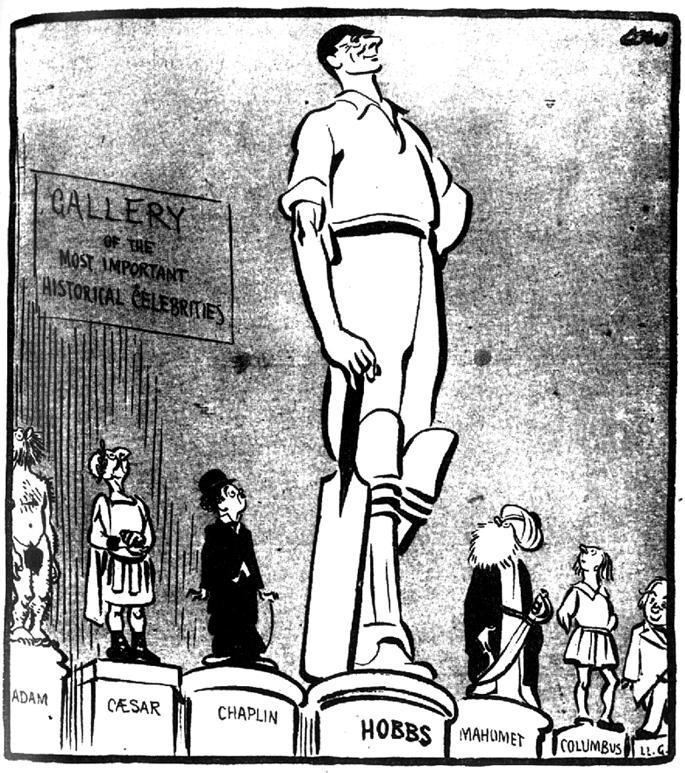Name David Low | ||
 | ||
Died 19 September 1963 (aged 72) Kensington, London, England | ||
David Low
Sir David Alexander Cecil Low (7 April 1891 – 19 September 1963) was a New Zealand political cartoonist and caricaturist who lived and worked in the United Kingdom for many years. Low was a self-taught cartoonist. Born in New Zealand, he worked in his native country before migrating to Sydney in 1911, and ultimately to London (1919), where he made his career and earned fame for his Colonel Blimp depictions and his merciless satirising of the personalities and policies of German dictator Adolf Hitler, Italian dictator Benito Mussolini, Soviet dictator Joseph Stalin, and other leaders of his times.
Contents
- David Low
- Early life
- Early career
- Move to England
- World War II
- Remainder of career
- Personal life
- Collections
- Selected works
- References

Low was born and educated in New Zealand. His first work was published when he was only 11 years old. His professional career began at The Canterbury Times in 1910. The following year he moved to Australia and worked for The Bulletin. His work attracted the attention of Henry Cadbury, the part owner of The Star, and Low moved to London in 1919, working for that paper until 1927, when he moved to the Evening Standard. There he produced his most famous work, chronicling the rise of fascism in the 1930s, the policy of Appeasement, and the conflict of World War II. His stinging depictions of Hitler and Mussolini led to his work being banned in Italy and Germany, and his being named in The Black Book.

Early life

The son of chemist David Brown Low and Jane Caroline Flanagan, David Low was born in Dunedin on 7 April 1891, and attended primary school there. His family later moved to Christchurch, where Low briefly attended Christchurch Boys' High School. However following the death of his eldest brother, Low was taken out of school, as his parents believed that he had been weakened by over studying. Low's first cartoon was published in 1902, when he was 11 years old, a three-picture strip in the British comic Big Budget.
Early career

Low began his career as a professional cartoonist with the Canterbury Times in 1910. In 1911 he moved to Sydney, Australia to join The Bulletin. During his employment at The Bulletin, Low became well known for a 1916 cartoon satirising Billy Hughes, then the Prime Minister of Australia, entitled The Imperial Conference. After that success, Low published many cartoons depicting Hughes' forceful and eccentric personality. Hughes was not impressed and apparently called Low a "bastard" to his face. A collection of Low's cartoons of Hughes entitled The Billy Book, which he published in 1918, brought Low to the notice of Henry Cadbury, part-owner of the London Star. In 1919 Cadbury offered Low a job with the Star, which Low promptly accepted.
Move to England
In England, Low worked initially at the London Star from 1919 to 1927. The London Star sympathised with his own moderately left-wing views. In 1927, he accepted an invitation from Max Aitken to join the conservative Evening Standard on the strict understanding that there would be no editorial interference with his output. Low produced numerous cartoons about the Austrian Civil War, the Italian invasion of Ethiopia, the 1936 Summer Olympics, the Spanish Civil War, and other events of the interwar period. He also worked with Horace Thorogood to produce illustrated whimsical articles on the London scene, under the byline "Low & Terry".
In 1937, Nazi Propaganda Minister Joseph Goebbels told British Foreign Secretary Lord Halifax that British political cartoons, particularly those of Low's, were damaging Anglo-German relations. In 1937 Low had produced an occasional strip about "Hit and Muss" (Hitler and Mussolini), but after Germany made official complaints he substituted a composite dictator, "Muzzler". After the war, Low is said to have found his name in The Black Book, the list of those the Nazis planned to arrest in the aftermath of an invasion of Great Britain.
World War II
His works are featured in many British history textbooks. One of Low's most famous cartoons, Rendezvous, was first published in the Evening Standard on 20 September 1939. It satirises the cynicism which lay at the heart of the Molotov–Ribbentrop Pact, depicting Hitler and Soviet dictator Joseph Stalin bowing politely before each other after their joint invasion of Poland, but nevertheless greeting each other respectively as "the scum of the earth" and "the bloody assassin of the workers". On 1 September, the Germans invaded Poland from the west and, on 17 September, the Soviets invaded from the east.
The Harmony Boys of 2 May 1940 depicts Hitler, Stalin, Italian dictator Benito Mussolini, and Spanish dictator Francisco Franco "harmonizing" and getting along quite well. When this cartoon was published, the German invasion of the Soviet Union was still more than a year in the future.
His satirical works met much criticism in the British public eye. The British press called him a "war monger," and many citizens felt disdain for his depictions of appeasement.
Remainder of career
Low remained in the United Kingdom for the rest of his career. He left the Evening Standard in 1950. That same year, he moved to the Daily Herald and stayed there until 1953. Finally, Low moved to the Manchester Guardian and was there from 1953.
Low received a knighthood in the 1962 Birthday Honours and died at his home in London on 19 September 1963. His obituary in The Guardian described him as "the dominant cartoonist of the western world".
A blue plaque commemorates Low at 33 Melbury Court, Kensington.
Personal life
Low married Madeline Grieve Kenning of Auckland on 7 June 1920 in St. Paul's Church, Covent Garden; they lived for many years in Golders Green, North London. The couple had two daughters: in 1939, Time described Low's breakfast as "a political meeting, with the cartoonist, his wife, and his two young daughters threshing out the news." Low died on 19 September 1963. His wife and daughters survived him.
Collections
United Kingdom
Political Cartoon Gallery 16 Lower Richmond Road, London SW15 1JP Collection of Low's original cartoons from the Evening Standard and The Manchester Guardian, as well as original caricatures from his New Statesman series.
Australia
